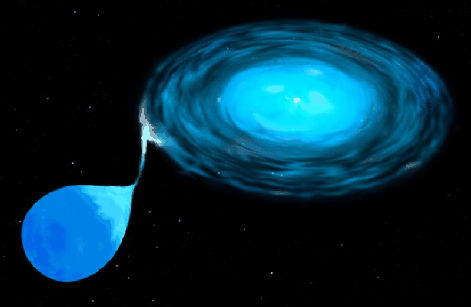
|
Explanation: Our Sun is unusual in that it is alone - most stars occur in multiple or binary systems. In a binary system, the higher mass star will evolve faster and will eventually become a compact object - either a white dwarf star, a neutron star, or black hole. When the lower mass star later evolves into an expansion phase, it may be so close to the compact star that its outer atmosphere actually falls onto the compact star. Such is the case diagrammed above. Here gas from a blue giant star is shown being stripped away into an accretion disk around its compact binary companion. Gas in the accretion disk swirls around, heats up, and eventually falls onto the compact star. Extreme conditions frequently occur on the surface of the compact star as gas falls in, many times causing detectable X-rays, gamma-rays, or even cataclysmic novae explosions. Studying the extreme conditions in these systems tells us about the inner properties of ordinary matter around us.
Tomorrow's picture: Nova Cygni 1992
|
January February March April May June July August September October November December |
| ||||||||||||||||||||||||||||||||||||||||||||||||
NASA Web Site Statements, Warnings, and Disclaimers
NASA Official: Jay Norris. Specific rights apply.
A service of: LHEA at NASA / GSFC
& Michigan Tech. U.
Based on Astronomy Picture
Of the Day
Publications with keywords: accretion disk
Publications with words: accretion disk
See also:
- APOD: 2025 May 6 Á The Doubly Warped World of Binary Black Holes
- APOD: 2025 May 4 Á Spin up of a Supermassive Black Hole
- APOD: 2024 May 8 Á Visualization: A Black Hole Accretion Disk
- The Doubly Warped World of Binary Black Holes
- APOD: 2020 August 25 Á Visualization: A Black Hole Accretion Disk
- Animation: Spiral Disk around a Black Hole
- Massive Black Hole Shreds Passing Star
